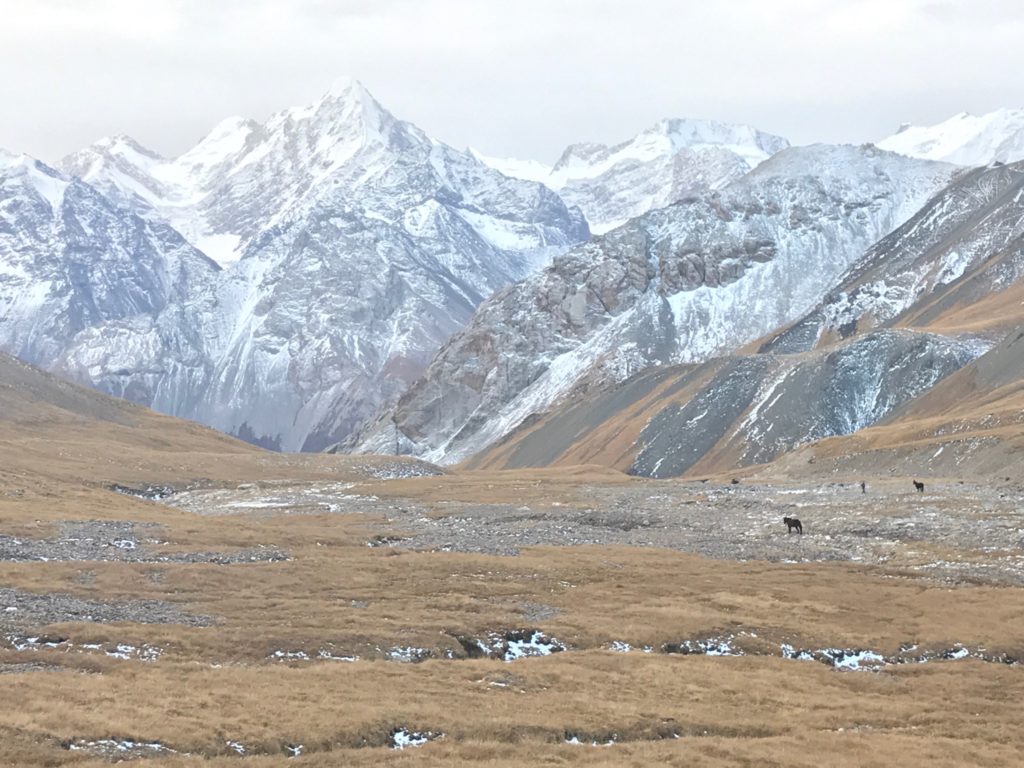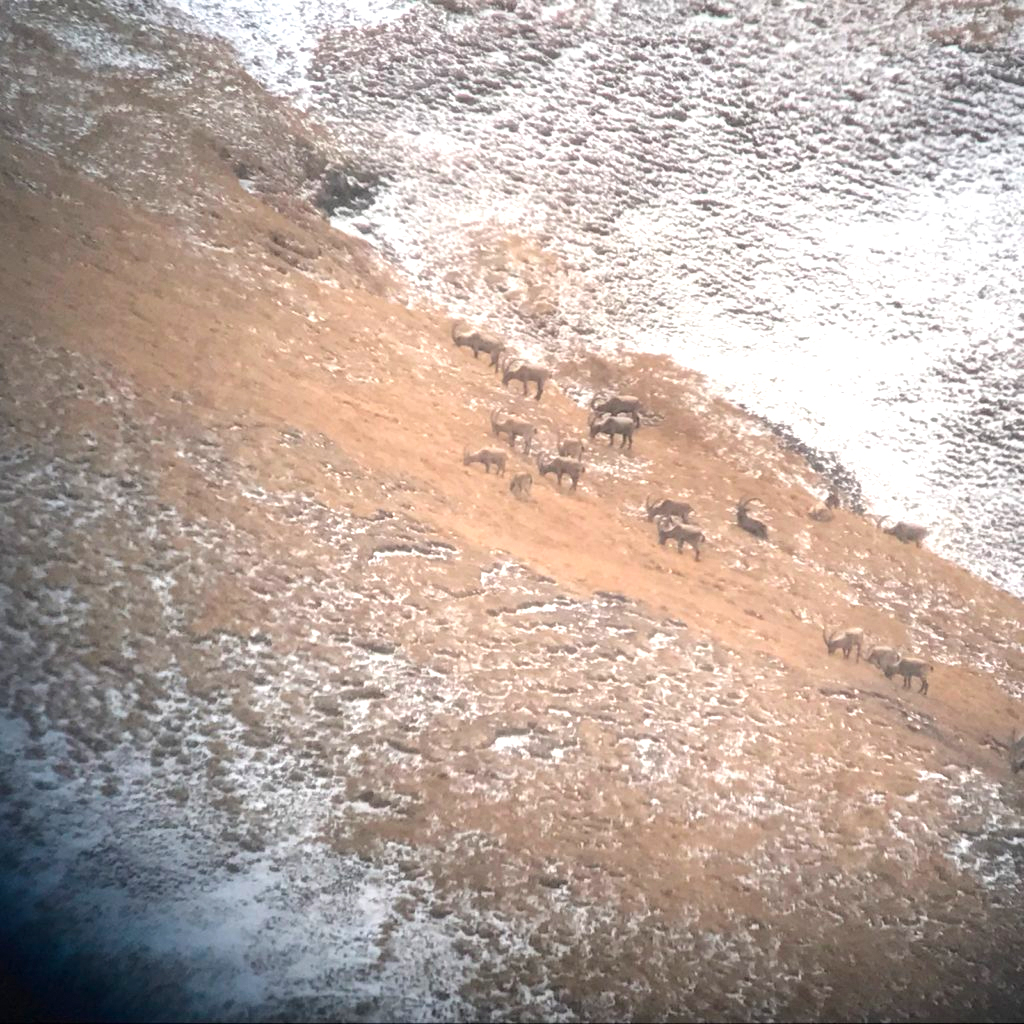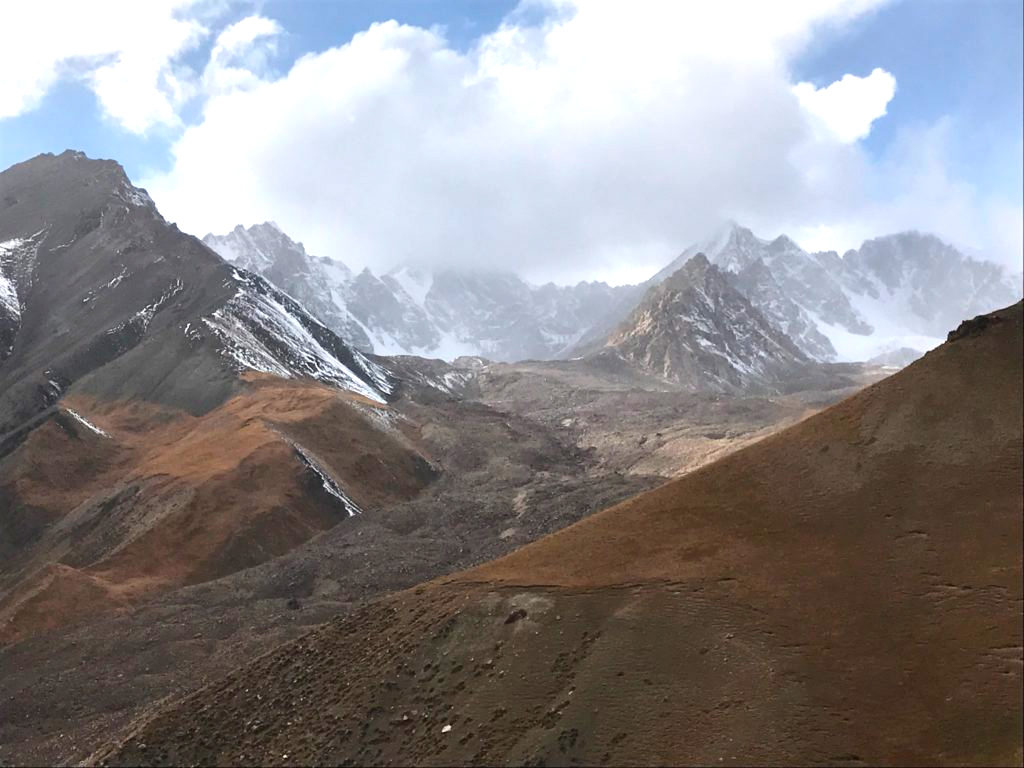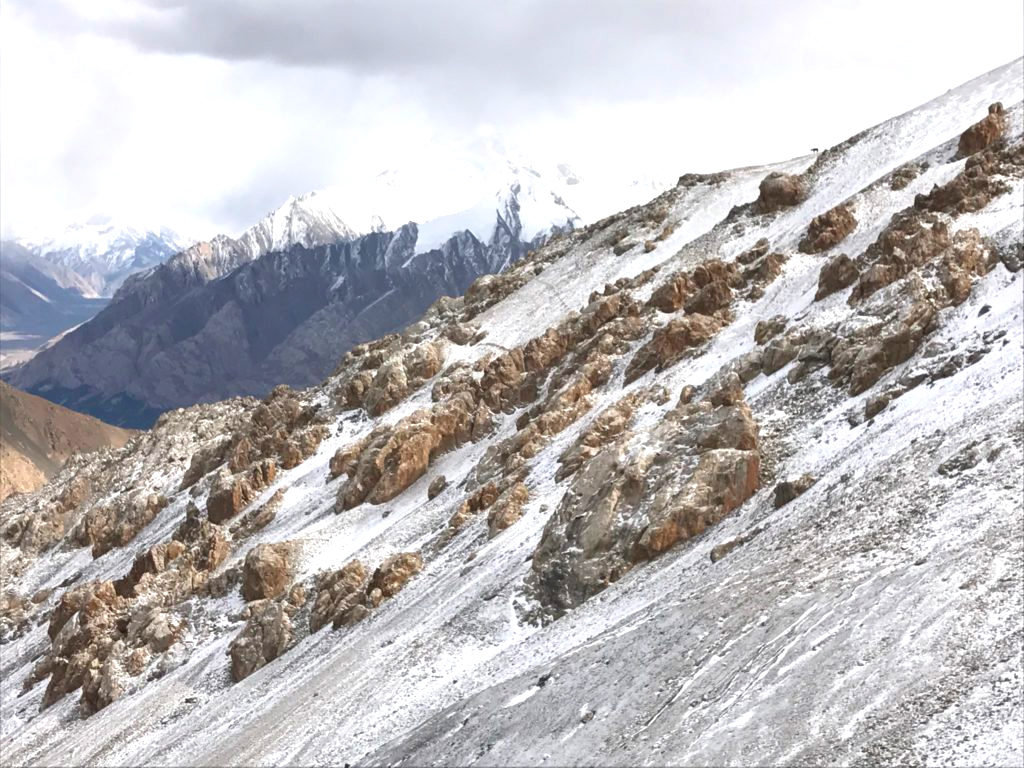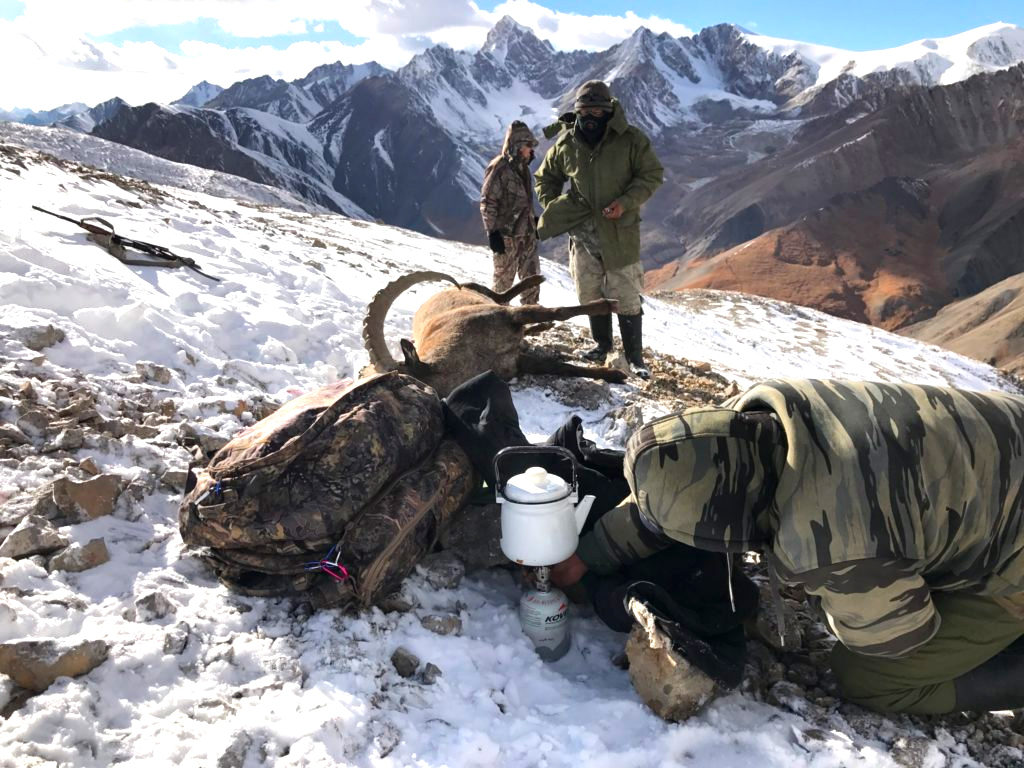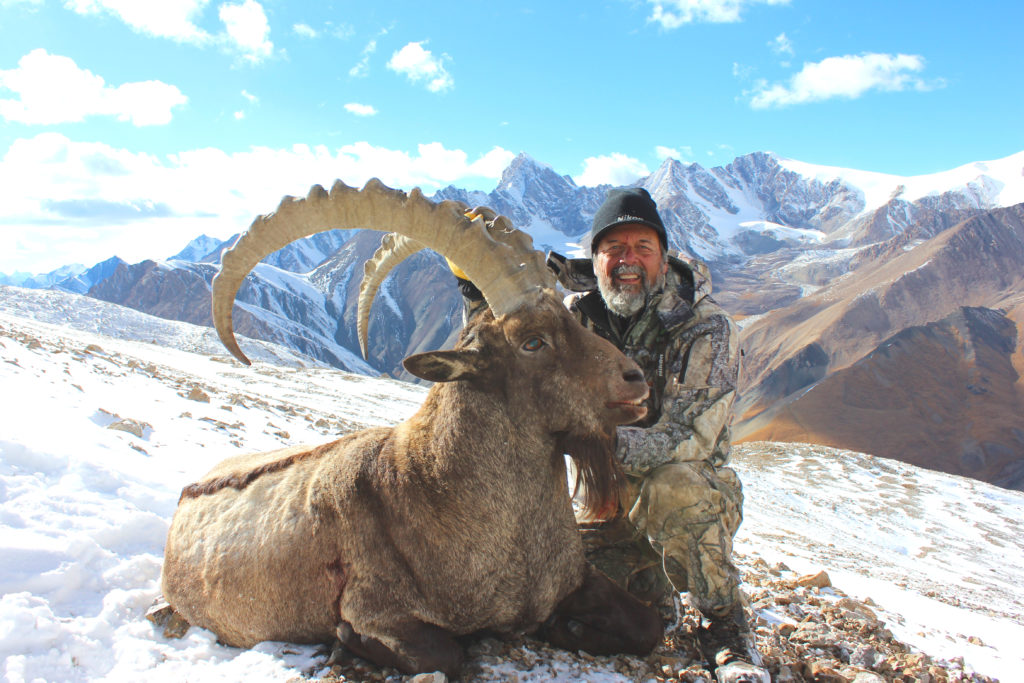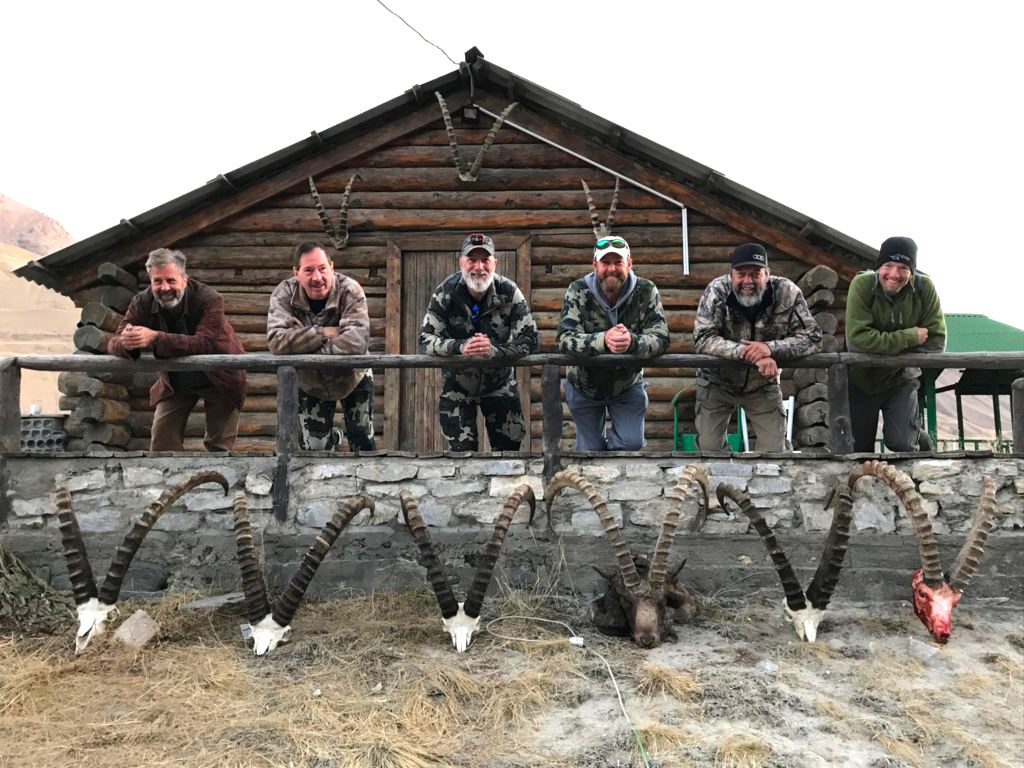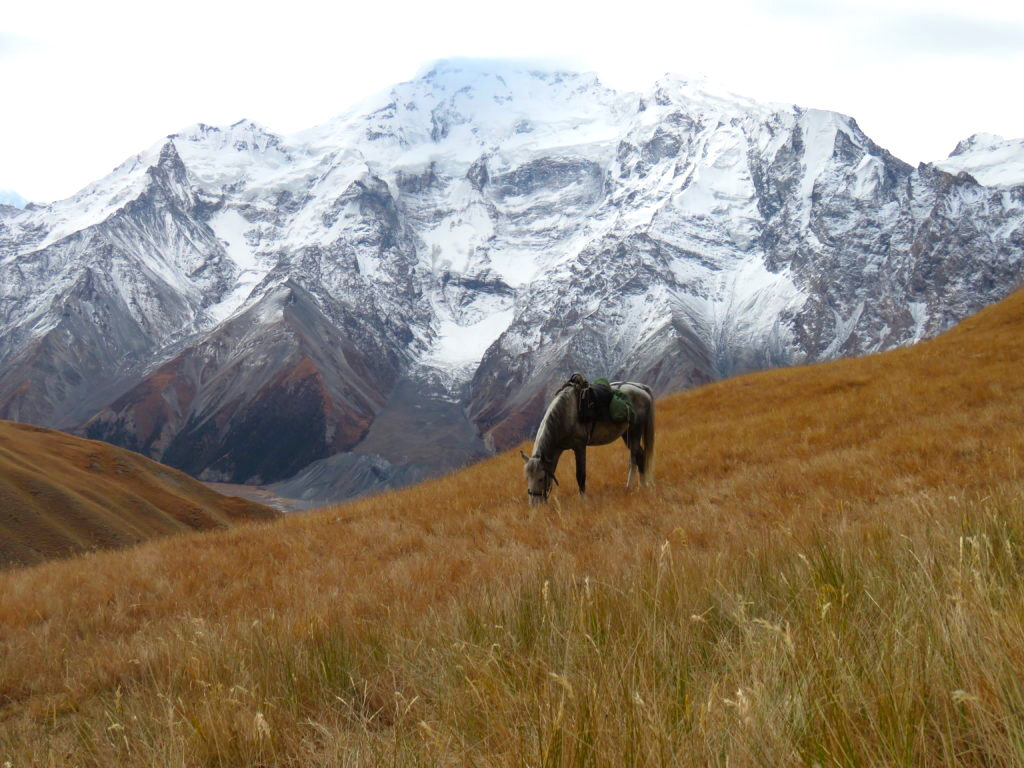Perilous Passage
Mountain hunters understand and accept the inherent perils of their pastime. When getting to the mountains is more dangerous than hunting in them, it’s not so acceptable. Given the option of riding “shotgun” I gladly accepted, avoiding cramped 3-wide seating in the rear of the American-made Toyota 4-Runner. The broken front seatbelt was a minor concern at the outset, but that quickly changed. Kyrgyz drivers make their own travel lanes despite painted delineators, and passing blindly is engaged like it’s a sporting event. Speed sometimes doubled the posted limit – a fact that did not go unnoticed by traffic authorities. We were stopped twice, and these were the shortest duration traffic stops I have ever witnessed. The “fines” were paid in a matter of seconds with pre-counted bundles of cash, and no paperwork. Additional stops for food and fuel and camp supplies and “rest” for our drivers made the 12-hour trip drag on, and on…
The pre-darkness part of our drive along the north shore of Issyk-Kul Lake – a branch of the historic Silk Road – was scenic but quickly became nerve-racking after dark. More than 100 miles long, this is the largest mountain lake and the second largest saline lake in the world – so although surrounded by spectacular snow-capped peaks, it never freezes. The 2-lane road was lined with big trees and full of holes, as might be expected in such a poor country. Shortly after dark we came upon an accident scene. A freight truck was perched upside down against one of those trees on our side, after crossing oncoming traffic and flipping end-over-end. This slowed our speed, but only temporarily. I had been noticing horses occasionally crossing the road just at the illuminating limits of our headlights – some with riders, some without. Suddenly, there was a mangled and bloody horse lying dead in the right lane, with no sign of a rider as we flashed by on the left.
An hour later after rounding the southeastern end of the lake, we took a late dinner break in Karakol, capital city of the Issyk-Kul Region. Continuing south and into the Teskey Ala-Too Range of the Tien Shan’s, we soon left the relative comfort of pavement. For the next 2-1/2 hours, SUV suspensions and passenger bladders were thoroughly tested as we climbed into the mountains. Grumblings about “the hunt from hell” circulated as we paused to remedy a case of motion-sickness. The lone access route to our hunt area passed through a military base, complete with security fencing and armed guards. On arrival, our passports were checked and matched with an authorized trespass manifest – but there was a problem with the papers for one member of our party. After some delay and yet another negotiation, a hefty “fine” was paid, and we were good to go. We finally arrived at base camp around 4:00 AM, exactly 4 days after leaving my home in Arizona. I don’t know who said “getting there is half the fun” but hopefully, they were wrong!
Into the Mountains on Horseback
Base camp (aka Big Camp) consisted of several buildings, situated at 9,000 feet on island-like mounds that extended into the nearly mile-wide riverbed on the floor of an enormous valley. After just a couple of hours sleep in the surprisingly comfortable hunter’s quarters, we gathered in the dining area for breakfast. During the next two hours, we learned the ibex were ranging from 12,000 to 13,000 feet – much higher than expected, and nosebleed territory for sure. The original plan called for 7 full days of 1-on-1 hunting, but we had already lost 2 days. And, with 3 rifles for 6 hunters, we would need to double-up. This effectively (and fluidly) cut individual hunting time by nearly 75%. As time passed, it was apparent that organizational issues were causing delays in getting this hunt started, and the language barrier compounded our frustration. Thankfully, Jose and Halit were with us to light fires where needed and keep things moving.
Wranglers appeared on the hillside above camp, driving horses into a large holding pen and then selecting individuals to be saddled and loaded with gear. The call came to bring our hunting gear and rifles to the makeshift “shooting range” – an old mattress positioned on a dirt bank facing cardboard boxes placed at 100 and 300 meters. Assuming I would be hunting with roommate Mike Fox, I fired two shots with his rifle. Camp workers hiding behind bushes near each target radioed the result of each shot. Jose assembled the rental rifle, and handed it to me for testing. Ten minutes later we located the ammo. Using the main crosshairs on the reticle that looked like a jigsaw puzzle in this 10x scope, I center-punched the black dot on the 100-meter box. When shooting concluded, Mike was first to leave camp – in an old Russian military jeep. Jim departed with Halit and a couple of Kyrgyz guides in an old troop transport truck. Tim, Tom and Jose left with their entourage of locals in the two SUVs. Each hunting party motored to locations where wranglers waited with horses that would take them into the mountains.
Only Steve and I (and the rental rifle) remained. We had noticed one of the guides seemed to be a take-charge guy, as he gathered gear and supervised preparation of several horses. This was Bek Baknazar, one of the best and most respected ibex guides in Kyrgyzstan. Steve and I would ride with him, his son Taka and assistant Ershan, from Big Camp into the mountains. We headed toward China. Across the expansive riverbed, and through several glacier-fed streams, we rode in the exact opposite direction from the others – five riders and five horses. I remember questioning in my mind why we were not taking an extra horse or two, as more than a dozen remained in the holding pen. Shortly into our ascent we had to dismount and lead the horses where footing was loose and the trail too steep to ride safely. This exercise was repeated often over the next few days.
The higher we rode the more spectacular our surroundings became, as we approached the first series of snow-capped peaks and valleys. Light brown, granular and often slippery terrain that featured stands of giant fir trees transitioned into broken, angular rock above timberline that was often jet-black in color. Contrasts were dramatic. Breathtaking crags disappeared into clouds of their own making, and it was soon apparent why the Tien Shan’s are known as the “Celestial” (from Chinese) or “Heavenly” mountains. Formed in the Cenozoic era as part of the Himalayan orogenic belt, they are considered among the most rugged mountains on Earth, with more than a dozen peaks topping 20,000 feet. After riding 4-1/2 hours we entered a mile-long valley blanketed in yellow grass. Horses were unloaded and a spike camp quickly setup on a bench at the upper end. It was a short break and we soon mounted up, climbing a nearby ridge in search of ibex. That afternoon as darkness approached, I saw my first wild ibex in their native habitat. Near the top of a distant ridge, a small herd of young billies and nannies with a couple of kids were settling in for the night. Soon it was time for us to do the same.
Most remote spike camps are spartan. Ours featured a thin nylon tent with broken zipper, five sleeping bags and a couple of thin foam mats. We were piled like sardines in the 8×10 tent, pitched on what appeared to be a flat spot – except for the large rocks and holes! Impossible to get comfortable, Steve and I got little sleep for the second night running. Hunt days began shortly after daylight, gathering the horses from their long night of feeding and wandering in the big canyon. After a breakfast of tea, Ramen noodles, a sliver of fatty sausage or a couple of sardines with plenty of bread and a small cookie or candy wafer, we mounted up and headed for the snow line around 13,000 feet. With Bek taking the lead we climbed to the ridge tops to glass, descending and then climbing again from one lookout to the next. This routine of searching for mature ibex billies with horns over 102-centimeters (40-inches) continued all day, and return to Small Camp was well after dark. With horses unloaded and turned loose, dinner was prepared – you guessed it – tea, Ramen noodles with some fatty canned meat mixed in, plenty of bread, and a cookie or candy. While it’s doubtful the nightcap shot of smooth Russian vodka helped us sleep given the conditions, this ritual was essential for attitude maintenance.
Horses are literally lifesavers in these steep and treacherous mountains, and I suppose they can also play a leading role in your accidental death. With so much ground to cover up and down, hunting here would be exceedingly difficult without them. I was expecting smallish animals like the native Mongolian horses but these Kyrgyz horses were good sized, calm, remarkably sure-footed and capable of packing tremendous loads. Farrier work was some of the finest I’ve seen, with special cleats at the rear of the shoes to prevent downhill slippage while side-hilling. Exceptionally steep slopes required hundreds of switchbacks to ascend/descend. The horses would spin on their uphill hind foot like a cutting horse with each 180-degree directional change. Often tied together for safety, any hesitation while facing uphill during these maneuvers could cause them to flip over backwards. Fortunately, accidents were few. Tim Herald had one when his horse “Bob” stumbled in a marmot hole, throwing and dragging him when his boot hung-up in the smallish stirrup. In addition to bruises and a bloodied lip, he suffered a cracked rib and torn back muscle, and lost a half-day of hunting. It could have been much worse. Adding insult to injury, Bob bit him the following day!
Let’s Hunt
My horse wreck wasn’t as serious. I’ve owned horses most of my life, but haven’t ridden much the past few years… and I paid the price. Besides a nasty sore from an ill-fitting saddle, my face was bloodied when my steed balked at crossing a sizeable chasm in a boulder-field, reared, and then attempted to leap across. He failed… and I was hurtled face-first into the rocks with 30+ pounds of gear on my back. Remarkably, my nose was not broken, though the nosebleed persisted for a couple of days. Later that day, we located a group of 14-15 billies with a couple of large-bodied mature animals in the group. At each stop where ibex were spotted, Bek would call for the “Big Scope” – my 20-60x82mm Nikon Monarch Fieldscope, with Phone Skope attached iPhone. He spoke little English, so after looking over the animals he would use his finger to “write” an invisible number on his opposite palm. “100” (indicating horn length just shy of 40-inches) was the common notation, and Steve would shake his head and counter with “120” to remind Bek of our somewhat lofty expectations for something closer to 50-inches. This time, Bek pointed repeatedly to a heavy-horned billy on the screen that I could tell he wanted us to shoot. It was 454 meters and steeply downhill with wind gusting from an approaching snowstorm. Steve declined, but I decided to go for it. The shot felt good but missed by a couple of inches on the downwind side.
It was a long, solemn and mostly miserable ride back to camp. When the storm caught us, we were pelted by BB-sized snowballs, and then got a broadside shellacking with snowflakes driven by relentless winds as the temperature plummeted. Traversing 45-degree rocky slopes on 8-inch wide goat trails will keep your attention focused under ideal conditions – in a near whiteout in the dark, it bordered insanity. Brilliant LED headlamps were useless, and I could see very little. Thank God the horses were steady, legendary Kyrgyz horsemanship prevailed, and we made it to Small Camp safely.
Next morning, the complexion of our valley had been transformed from a glowing golden to a glistening white. Taka’s horse was lame, so he stayed in camp while Bek, Ershan, Steve and I rode back to the area we hunted the previous day. On reaching 13,000 feet we immediately located tracks in the fresh snow, but had difficulty locating the ibex that made them. After checking two lower drainages we circled back up to a saddle that separated two deep canyons. Bek spotted a dark triangle in a sheer rock face 1500 yards down the larger canyon, and called for the big scope. Remarkably, it was a bedded ibex billy and within a few minutes, others appeared in the rocks. Two had horns that Bek estimated at “105” with his usual signing. Pointing an index finger at me, and then cocking his thumb and pointing toward the ibex, he was asking if I would shoot. Honestly I felt a bit pressured, and knew that Steve was anxious to continue searching for longer horns. But with just over two days of hunting time remaining, odds of finding two 50-inch billies were now slim… I nodded yes, but could see no way of closing the distance for a shot.
Bek huddled with Ershan, who mounted up and rode off. He was apparently going to try driving the ibex to a more favorable location. The rocky, snow-covered terrain was so rugged and vast that Steve and I thought this maneuver had little chance of success… we were wrong! An hour later the ibex began to stir and Bek motioned for me to get ready to shoot. With Ershan now on foot attempting to circle their position, they followed their instincts by moving up the opposing mountainside for safety. The best of the 9 billies was differentiated not by his large, heavy horns, but instead by his long dark beard. Watching these monarchs ascend through the rocks with leaps and bounds was an experience I will never forget.
Calm quickly turned into chaos. With the ibex rushing into range on the opposing ridge and Bek alongside with my new Nikon LaserForce rangefinder/binocular, I steadied the rental rifle on my pack. Previously a non-issue, the language barrier suddenly became a problem as Bek was unable to give me the range. Lowering the rifle and grabbing the optic, I ranged the long-bearded billy at 403 meters, adjusted for the steep uphill angle. My first shot in the gusting crosswinds missed, but the second staggered the massive animal. A third shot was sent off toward China, as Bek bumped my pack at just the wrong time while exclaiming “wounded” repeatedly, but the fourth shot was perfect. The magnificent 8-year old, 42-inch billy stubbornly laid down to assume his final resting place near the top of the snow-covered ridge.
It took awhile to reach the fallen animal, and Ershan arrived as we prepped for photos. He positioned our packs for a windbreak to boil water for tea, before getting down to the business of processing our prize for packing off the mountain. The brew warmed from within – a nice way to begin this arduous task in the frigid conditions. Reaching under his coat, Bek pulled out his knife – a stunning heirloom adorned with family crest, silver butt and bolster, and stag handle featuring delicate pearlescent inlays. There were no words or ceremony, yet the display left no doubt that the well-worn Damascus steel blade of this patriarchal implement would be used to breakdown this ibex, just like countless others. This was a moment of cultural epiphany for me…
Well before work was completed, Bek pointed at our packs and then “walked” two fingers across his palm. Interpretation: Grab your packs and head for camp! As Steve and I bailed off the ridge at 13,737 feet, several things came to mind. With daylight fading fast and the temperature falling below zero, we were several miles from camp and facing a variety of 700 to 1,000 foot descents and ascents on foot. This was going to take all night, and I questioned my fitness for the task. Facing the second major ascent an hour later, with lungs starting to burn and legs feeling rubbery, we heard horses approaching from behind. Bek and Ershan caught us, and we were invited to ride the rest of the way to camp. After unloading and releasing the horses, Bek pulled out a small flask of cognac to toast our success.
The following morning was clear and brutally cold – so cold that the stream running below camp had frozen, water bottles protected inside our tent froze solid, and my fingers froze inside unlined fleece gloves. Breath condensation must have dampened the gloves, and the resulting case of frost nip painfully compromised dexterity for a couple of weeks. We broke camp after breakfast, loaded up and rode toward Big Camp. Two hours later we stopped to repack, and then separated. Bek, Ershan and Steve turned north to hunt new territory, while Taka and I headed on to Big Camp with my ibex. We arrived to find 3 sets of horns boiling in a giant kettle. Jim had wasted no time in taking his ibex the first day. Returning to the comforts of Big Camp that evening, he was treated to hunts for partridge and rabbits on following days. Both Tom and Mike scored on their first full day in the mountains. Tom made a 450-yard shot with a borrowed rifle on a beautiful 46-inch billy. Mike rock-crawled several hundred yards up a canyon for his truly massive-horned ibex, featuring 13-1/2 inch bases. He shot it with a cartridge autographed by his granddaughter for good luck.
Our final day of hunting dawned, and talk around camp was that 4 out of 6 wasn’t bad. I was confident that Steve would be successful hunting with Bek and sure enough, they rode into camp early that afternoon with a great billy much like my own. Located just before dark the prior evening, they spent the night in silence as close to the herd as they dared. Forgoing the noise of pitching the tent, they slept in a ditch along the route that Bek suspected the ibex would travel to feed the next morning. The master guide’s suspicion proved correct, and Steve shot his billy with the rented Blaser at just 50 yards.
Around 8:00 PM we got word in camp that Tim had an extraordinary 49-inch billy down, but their horses had run off and he and his guide were stranded. It took some time to assemble a “rescue” party from the group of guides and locals in camp, as they had been “celebrating” the end of the hunt for several hours. Tim finally made it back around 3:00 AM, and after a few days of reflection, described this hunt as the most physically and mentally demanding of his life. I would have to concur. Remarkably, we had gone 6 for 6 with mature 40+ inch ibex billies in only 4-1/2 days, using mostly borrowed and rented rifles, in some of the most rugged mountains in the world.
We gathered early the next morning for a group photo session, and completion of the paperwork for our trophies with the government gamekeeper. I was impressed with the thoroughness of the documentation, which took more than an hour to complete for each animal. The 12-hour return trip to Bishkek was less eventful, but stretched to 14 hours thanks to a flat tire and the insistence of Mohammed’s uncle on plugging the hole (several times) instead of bolting on the spare. We checked into the stylish Plaza Hotel and spent the following day wandering around the city. Early the next morning, Tim, Tom, Steve and I departed for Istanbul, where we were met by a Shikar Safaris local representative, Hakan Ozsala. He escorted us on a full day of touring historical sites in old town Constantinople – Hagia Sophia, Byzantine Hippodrome, Blue Mosque – and some serious gift shopping, before capping the day with a fabulous seafood dinner on the waterfront. This 20-hour layover was a highlight, and I hope to return someday for a longer visit in this amazing city that spans two continents.
I’m often asked if I bring meat home from international hunts. In most cases this is not possible due to legal issues, not to mention impractical on remote hunts like this one that required days of travel. Nevertheless, not a scrap of meat goes to waste. One ibex dinner was prepared for us before we left Big Camp, and the rest was distributed to staff, hired help and other nomadic locals. Passing through the military installation on our departure, my passport was checked by a young Kyrgyz soldier named Johnny. He was professional and surprisingly formal, considering that we had met and chatted two days prior, when I returned to base camp with my ibex. He worked at camp on his days off from soldiering and patrolling in search of Chinese who cross the treacherous mountain border illegally. Returning my passport, he said with a somewhat less formal and much softer tone, “my mother thanks you for the ibex meat.” Apparently received in exchange for his work in camp, he had already made the roundtrip of several hours to provide his family with fresh meat. The feeling that my success resulted in giving a little back was truly gratifying.
My heartfelt thank-yous go to Bek, Ershan, Taka and the other Kyrgyz guides for their hard work, locating the ibex in the vastness of the Tien Shan mountains, creating opportunities and keeping us all safe in the mountains. Special thanks also go to outfitter Shikar Safaris and our agent Worldwide Trophy Adventures. Without the expertise of these two companies in hunting the wildlands of the world, this dream would not have become reality. Additional thanks go to the staff and helpers at Big Camp, and to sponsor companies Eberlestock, Nikon Sport Optics and 1800GunsAndAmmo.com for providing equipment for this unforgettable adventure.
Within a few days of returning home, our four missing gun cases (and Steve’s duffle) were delivered by the offending airlines. Now just one question remains: Does this old graybeard still have one more mountain hunt left in him?


